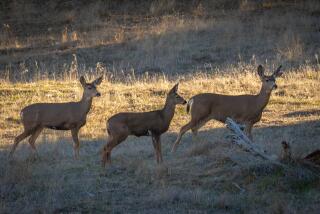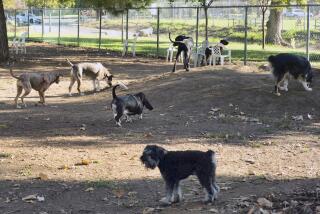New Element to Wisconsin Deer Hunt: Chronic Wasting Disease
WAUSAU, Wis. — The state’s traditional deer hunt opens Saturday with hunters wondering for the first time whether their prey is infected with a rare, always fatal brain disease.
There are no documented cases of chronic wasting disease being transmitted from deer to humans, but scientists say they cannot rule out the possibility.
Wisconsin officials have instructed hunters in how to avoid potentially infected parts of the carcass while dressing their kill, but they have not advised anyone against eating venison.
Sales of licenses for hunting deer are down 15% from a year ago, and officials blame concern about the disease.
George Nowak, 71, of Wausau refused to buy a license this year, ending a lifetime of hunting that began when he was 12.
“This is something you look forward to, hunting season. But the chance of getting some awful disease is just not worth it,” he said. “If you can’t eat it, why shoot it?”
The illness is related to so-called mad cow disease in cattle and Creutzfeldt-Jakob disease in humans. The ailments are believed to be caused by proteins called prions, which make sponge-like holes in the brain.
In February, chronic wasting disease was found in Wisconsin deer, marking the first time it was discovered east of the Mississippi River. It is known to exist in deer or elk in at least eight states and Canada; thousands of animals are being slaughtered in attempts to contain it.
Despite the concern, more than 500,000 licenses have been sold for the nine-day Wisconsin hunt, and there was never any suggestion that the deer season be called off.
Deer hunting is a $1-billion industry in Wisconsin, and it ranks up there with Green Bay Packers football and cheese as cherished Wisconsin traditions. Some high schools even cancel classes during hunting season.
State agencies have advised hunters not to cut into the animals’ spinal cords and lymph nodes, where the deadly proteins that cause the disease accumulate. Hunters were also advised to wear disposable gloves and use disposable knives and saws.
The state estimates 1.6 million deer roam Wisconsin this fall, and officials hope hunters kill 450,000 to 500,000 of the animals. But the officials said that, because of worries about the safety of the venison, some hunters may try to shoot only large bucks for their trophy horns.
The state wants hunters in every county to donate a total of 50,000 deer heads for testing for the disease in what it calls the biggest wildlife disease survey ever conducted.
“It is a historic season,” said Brad Koele, an assistant deer ecologist for the state Department of Natural Resources.
Illinois officials also hope to test deer heads for the disease with help from participants in a three-day hunt that begins today. Last month, Illinois confirmed its first known case of the disease in a deer shot near the Wisconsin state line.
The Wisconsin hunt continues an unprecedented attempt to kill all deer -- at least 25,000 of them -- in an area west of Madison where the disease was discovered in the state.
Ron Erickson, 36, a hunter from Owen who bought his license Thursday, said he would not shoot a sickly looking deer.
But apart from that, “I am not really worried about CWD,” he said. “I hope a bunch of other hunters go out there. Then there will be fewer deer I have to worry about hitting on the roads.”
More to Read
Sign up for Essential California
The most important California stories and recommendations in your inbox every morning.
You may occasionally receive promotional content from the Los Angeles Times.










